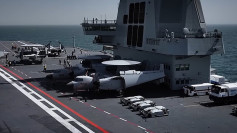Residents described the scenes as chaotic, reminiscent of a battlefield, with explosions heard everywhere. Alan Barrios, a local resident, shared his harrowing experience with the Honolulu Citizen-Reporter.
By August 11, wildfires that raged across Maui had resulted in at least 55 fatalities, with approximately 1,000 people unaccounted for. Thousands are displaced, and numerous historical structures have been reduced to ashes. Experts have identified climate change-driven drought, heatwaves, and hurricanes as major contributors to this devastating event.
Prof. Huang Xin of Nanjing University's Atmospheric Sciences department noted that extreme wildfires usually thrive under meteorological conditions of drought, high temperatures, and strong winds. Climate change affects weather patterns differently across regions, making fires more likely under combined conditions.
Bombardment on Lahaina
The governor of Hawaii labeled this fire as the "largest natural disaster in the state's history," according to the BBC. Roughly 80% of the historic town of Lahaina in West Maui has been destroyed, appearing as if it had been struck by a bomb.
Currently, 55 fatalities have been confirmed. The exact number of missing individuals remains uncertain due to disrupted island communications. John Pelletier, Chief of Police in Maui County, estimates that about 1,000 people are missing.
#Hawaii fire survivor recounts the night at sea with wife and five children "We held on"…
Follow for more such stories
Video credit - The Guardian#Hawaii #hawaiifires #MauiFires #Maui#LahainaFires #Lahaina #Help pic.twitter.com/dzTM2sQLO7 — Shadab Javed (@JShadab1) August 11, 2023
Starting on the evening of the 8th, the fire is now in its third day, with firefighters tirelessly battling the flames. Officials stated that none of the ongoing fires have been 100% contained, and the situation remains unpredictable. Adam Weintraub of the Hawaii Emergency Management Agency emphasized that rescue teams are spread out in the affected regions. Due to inaccessible areas, the death toll might still climb. In Lahaina, the fire spread rapidly, forcing many tourists to jump into the sea to escape, later being rescued by the coast guard. According to The Guardian, at least 30 individuals suffered injuries from burns or smoke inhalation. On the 10th, President Joe Biden issued a major disaster declaration and pledged to provide all available federal resources for recovery. He expressed his prayers for those who lost homes, businesses, and communities. Former President Barack Obama, a Hawaii native, expressed his profound sadness on Twitter after seeing the devastation. Local authorities have begun mass evacuations for both tourists and residents stranded in Lahaina, with over 14,000 tourists already evacuated. Maui government announced on social media that buses are being used to transport tourists and residents to airports and local shelters. Why Such a Tragic Toll? The exact cause of the fire remains undetermined. However, the Associated Press reported that the U.S. National Weather Service had issued warnings of strong winds and dry conditions to the Hawaiian islands before the fires started. According to The Guardian, the fire seemed to initially burn through vegetation and then, propelled by gusts exceeding 60 mph, rapidly spread to populated areas, setting aflame large sections of wooden buildings in Lahaina's town center. Residents scrambled to escape on congested roads, some of which were blocked by falling debris. Hawaii News Now reported stories from survivors who only had minutes to evacuate, leaving behind all their possessions. Currently in its dry season, wildfires are not uncommon in Hawaii during this period, but recent weather conditions provided ample "fuel" for this rare, large-scale fire, as pointed out by Thomas Smith, Associate Professor of Environmental Geography at the London School of Economics. This week's hurricane "Dora," passing south of Hawaii, caused a significant pressure difference between the northern and southern parts of the island, leading to unusually strong trade winds. The U.S. National Weather Service indicated that these powerful winds contributed to the initial outbreak of the fire, power outages, and grounding of firefighting helicopters. Other factors like sudden droughts and abundant flammable vegetation also aggravated the situation. About 83% of Hawaii is currently experiencing varying degrees of drought, according to U.S. drought monitoring data. The atmospheric scientist from the University of Wisconsin-Madison, Outkin, noted a significant two-level increase in Maui's drought severity within just three weeks between May and June. In such sudden droughts, the air extracts moisture from land and vegetation, increasing the likelihood of wildfires.
People in Hawaii, Maui are jumping in the Ocean trying to save themselves from the fires #Hawaii #hawaiifires pic.twitter.com/vzI7VyFN8J — T R U T H P O L E (@MrEccentricc) August 11, 2023
Previously, vast areas of Hawaii were cultivated with pineapples and sugarcane. With the closure of associated businesses, invasive flammable grasses, like Guinea grass, took over. Clay Trauernicht, a fire scientist at the University of Hawaii, highlighted that these grasses can grow up to 3 meters at a daily rate of 15 centimeters during the rainy season. Once dried, they provide ample fuel for fires.
Climate Change: A Key Culprit
The severe consequences of Hawaii's wildfires result from a combination of factors, with climate change playing a significant role.
Katharine Hayhoe, Chief Scientist at the Nature Conservancy, stated on social media that while climate change doesn't usually cause fires directly, it intensifies them, expanding the burn area and making them more dangerous.
The Guardian pointed out that this Hawaiian wildfire is "unprecedented." Wet tropical regions typically lack dry vegetation for fuel, but rising global temperatures are changing this narrative.
Research reveals that 90% of Hawaii has received less rainfall compared to a century ago, with significant drought since 2008. Another study found that since 1990, monitored sites on the island saw a 31% decrease in rain during the rainy season.
Studies also suggest that warming oceans due to climate change have led to stronger hurricanes globally. This is evidenced by the powerful winds that fueled the Maui fires.
Hurricane "Dora," recorded as a Category 4 hurricane by the U.S. National Weather Service, lasted 122 hours, setting a record for the longest-lasting Pacific hurricane. The fact that "Dora" was 500 miles away from Maui and still impacted the fire shocked scientists.
"These climate change-related disasters have surpassed what we were accustomed to handling," said researcher Copes-Gerbitz of the University of British Columbia's Forestry and Conservation Science department. "It's these interconnected challenges that culminated in a colossal disaster."





